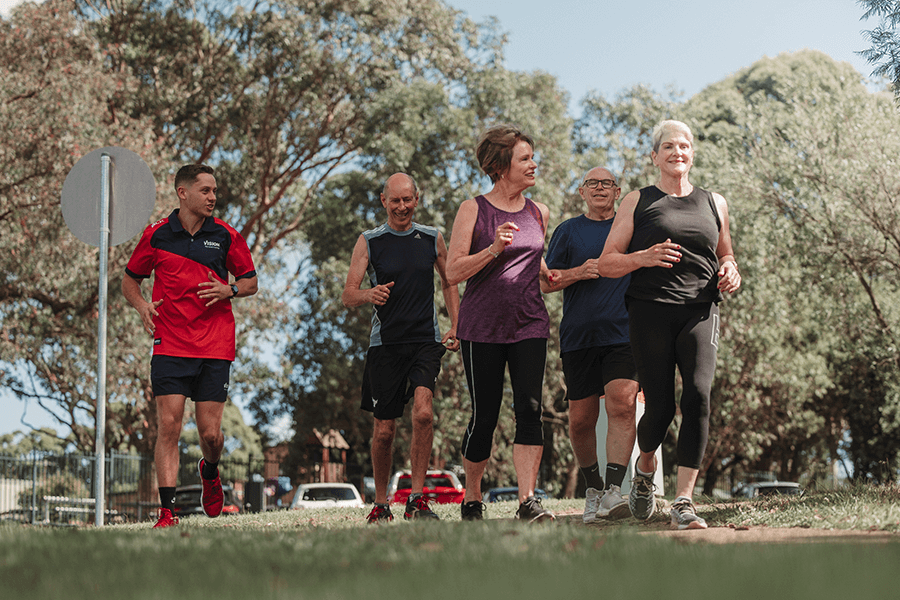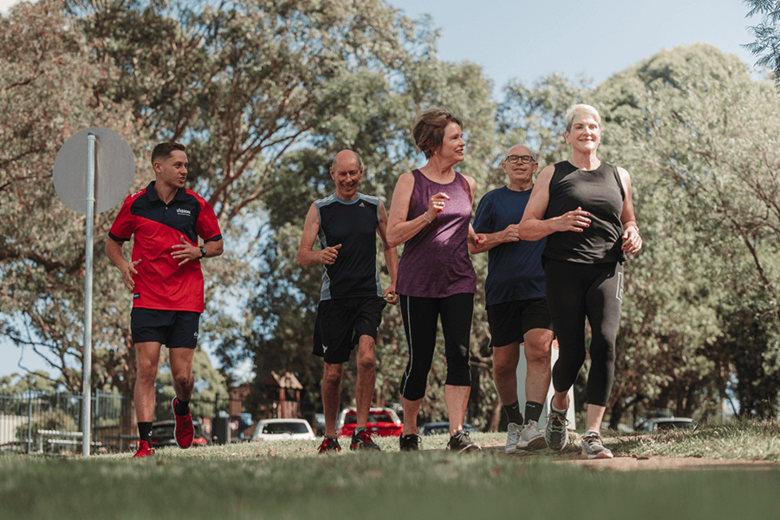Summary
Most people recognize the physical and mental health benefits of exercise, including reduced stress, improved heart health, and better insulin sensitivity. However, fewer people are aware of how physical activity positively impacts social well-being. [1].
Engaging in regular exercise helps build emotional resilience, fosters meaningful social connections, and enhances cognitive function. In this article, we explore four key social benefits of physical activity and how it can improve your overall quality of life.
Key Topics
- How exercise improves adaptability and resilience
- Building friendships through group fitness and social activities
- The impact of exercise on self-confidence and emotional well-being
- How physical activity enhances cognitive function and memory
Introduction
Physical activity is often associated with improving physical health, such as reducing the risk of heart disease, managing weight, and enhancing overall fitness. While these benefits are widely recognized, the social and emotional advantages of exercise are just as powerful—yet often overlooked.
Engaging in regular social physical activity fosters a sense of belonging, strengthens relationships, and improves mental well-being. Whether it’s a group fitness class, a team sport, or simply working out with a friend, exercise provides opportunities to build connections, confidence, and cognitive resilience.
In this article, we explore four key social benefits of physical activity and how incorporating movement into your daily routine can enhance not only your body but also your social and emotional health.
1. Improve your reliability and increase your adaptability
Social health factors in our ability to interact and form meaningful relationships with others. It is how comfortably we adapt in social situations. Just like training a muscle makes it stronger, physical activity can improve mental and emotional resilience.
With better emotional resilience, many exercisers believe that training increases the sense of control they have over their lives. Thus, making them more efficient and productive in general.
For many, exercise is more than physical training; it is also training for life. It can help with improving reliability and increasing adaptability.
By sticking to an exercise regime, whether twice weekly resistance training sessions or a marathon training plan, we bring structure, order, certainty and meaning to our life. A workout can be a means to create better versions of yourself on multiple levels. This in turn helps us adapt to situations when life does not go our way [2].
2. Finding your like-minded people
So what are some social benefits of physical activity? First and foremost, a community of like-minded people is the most significant. From a young age we are encouraged to play, usually through physical activity, and often participating in team sport. This is how we build social skills, learn how to collaborate and problem solve. In adult life, for many the connection found in a team setting is lost.
The gym, or any environment where physical activity is the focus, is a way we can rekindle this connection and provides many social benefits including a new found community. When we exercise in these spaces, we enter an environment that is typically known for being supportive and uplifting.
Especially in group settings, it allows us to engage in social interactions and make friends with similar interests to help motivate each other in pursuing fit & healthy lifestyles. We are exposed to others who share our goals and aspirations in improving themselves and bettering their health.
When we are part of a group of like-minded, value-driven people, we also get the support and accountability that goes with it. It has been shown that social situations have a bigger impact on health outcomes than almost anything else. Having the support of others is critical to success when it comes to physical health. We need significant, close connections with others for social health.
Physical activity helps build social relationships between people who share common interests. The ability to connect with like-minded people, gives a sense of purpose and reduces loneliness.
Also, as a result of being surrounded with like-minded people, it allows us to meet even more new people and form new friendships.
3. Making positive friends with a like-minded community
The benefits of physical activity on social health are endless! With improved self-esteem, more social opportunities and being better equipped to manage mental health, depression, and stress, exercise helps us to generally be more positive, well-rounded individuals.
Presenting with better emotional wellbeing and a more positive outlook on life, plus having better social skills, helps us show up for others. Our personal relationships and friendships benefit as a result. This can lead to a better relationship with ourselves and others.
Exercising with others is a great way to spend quality time with those important to us. When training with a friendship group, we are more likely to stay committed to our fitness goals and in turn help others stay on track to theirs.
Physical activity is a known mood booster, and when participating in exercise with a friend, everyone involved shares the positivity. Similarly, the act of participating in exercise can help distract from negative emotions and make us better able to handle negative situations.
4. Improving your memory
Cognitive decline and memory loss threatens independence and quality of life. There is strong evidence however suggesting physical activity can help in counteracting this potential decline [3].
Physiologically, exercise helps in reducing insulin resistance and inflammation. This, along with the production of growth chemicals in the brain and new blood vessels, results in increased blood flow and overall healthy brain cells. Physical activity can help us think, learn and problem solve: all contributing to an improved memory. In assisting with our emotional balance, exercise has also been shown to reduce depression and anxiety, plus reduce the risk of dementia. Studies have further emphasised the positive impact on memory, showing noticeable cognitive benefits in as little as four weeks [4].
Undertaking an active hobby, will further reinforce the physical, social and mental benefits obtained through activity. During activities where learning a new skill is the focus, you have to think while moving. This could be dancing, any type of sport, or something more complicated like a fitness class - anything where you are engaging your brain while being physically active.
Conclusion
Exercise is more than just a tool for improving physical health—it’s a pathway to enhanced social well-being. From finding like-minded friends to increasing adaptability, building confidence, and improving memory, regular physical activity enriches life in multiple ways.
By making movement a part of your routine, you not only strengthen your body but also cultivate valuable relationships and maintain cognitive function as you age. The key to long-term success is consistency—find an activity you enjoy, engage with a supportive community, and reap the benefits of both physical and social health.
FAQS
1. What are the social benefits of physical activity for middle aged adults?
As we age, our lifestyles change. Typically, older adults will start to live a more sedentary lifestyle. No longer as active as our youth. Working from home, spending our work day deskbound in front of a computer are the norm for many. As we move into middle age, we find ourselves socialising over food or drinks or favouring nights in front of the T.V. On top of this, the ever-growing reliance on technology in every way reinforces our sedentary lifestyles.
Similar to improving cognitive function, protecting our physical health has a greater impact on improving our quality of life and remaining independent. Engaging in physical activity not only increases our current level of physical fitness but also contributes to an overall improvement in our lifestyle. Making regular physical activity a part of daily life is one of the best ways to stave off injury and illness, allowing us to live more fulfilled lives. There are some fantastic social benefits of exercise! One being, our social skills and social life improve. We retain independence and autonomy. We develop a greater sense of self-identity and self-confidence. This in turn shows greater social health benefits. Those in good physical health will be more socially active and better able to contribute to family, friends and their community.
2. What are some recommended physical activities that can help improve social integration for middle-aged adults?
Statistics show only a small percentage of middle-aged adults meet the recommended amount of regular exercise [5, 6].
Social and health benefits aside, being physically active is a requirement of normal functioning and is one of the most important things we can do for our health and longevity [7].
Often cited as a barrier to exercising is time. However, it has been shown that less than 5 minutes of physical activity per day can have a profound improvement on our health and make us feel good [8].
With time out of the equation, oftentimes it is a matter of not knowing how to get started, or of confidence. Unless familiar with a gym environment, many middle-aged adults either do not feel comfortable or lack the know-how to train safely or effectively alone.
Enlisting the help of a qualified Personal Trainer, in a small friendly studio with like-minded people, like Vision, might well be the thing needed to get started but also to stay consistent. As well as accountability, a PT will ensure training is carried out safely and effectively to maximise benefit while minimising risk of injury. On top of this, not only do you get regular social contact with your trainer, but also the social connection from the studio community.
To reiterate, getting involved in a community group where fitness is the focus will improve social integration for middle aged adults - this could be joining a cycling club, taking up tennis or even Golf, just to name a few. Joining a run club or committing to an event, be it 5km or 50km helps to form and cement fast friendships. Long distance running is a great shared goal to experience with others on a similar path. The sense of achievement and community after completing something you’d not previously thought possible is exhilarating; along with that, the memories will last a lifetime.
Whereas there are no government recommendations for steps as intensity for number of steps can be variable, current World Health Organisation's recommendations are unanimous. These guidelines suggest a combination of moderate and vigorous activity of between 2.5-5 hours per week. Included in this should be 2-3 full body strength training sessions which allows a strong baseline of functional strength [9].
Consistency is key when it comes to fully appreciating both the social and physical benefits of physical activity. We typically see significant improvements in exercise adherence, and more importantly, outcomes and results, when we partake in exercise we enjoy. In essence, participating in exercises and activities you find enjoyable will help you sustain consistency in your exercise routine.
Find an environment that is supportive and that you feel comfortable in. Find something you enjoy, that fits in with your lifestyle and it will yield the desired results.
References
[1] https://onlinelibrary.wiley.com/doi/10.1111/sms.12581
[2] https://www.ncbi.nlm.nih.gov/pmc/articles/PMC4873055/
[3] https://pubmed.ncbi.nlm.nih.gov/27636853/
[4] https://www.ncbi.nlm.nih.gov/pmc/articles/PMC8829997/
[5] https://www.aihw.gov.au/reports/physical-activity/physical-activity#Do%20Australians%20meet%20the%20physical%20activity%20guidelines
[6] https://www.abs.gov.au/statistics/health/health-conditions-and-risks/physical-activity/latest-release
[7] https://journals.physiology.org/doi/full/10.1152/japplphysiol.00420.2011
[8] https://jamanetwork.com/journals/jamaoncology/fullarticle/2807734
[9] https://www.health.gov.au/topics/physical-activity-and-exercise/physical-activity-and-exercise-guidelines-for-all-australians/for-adults-18-to-64-years

